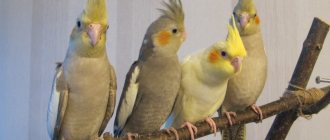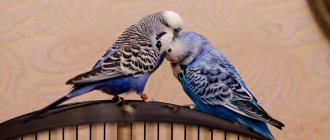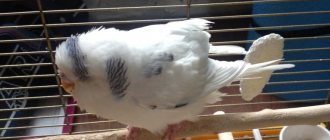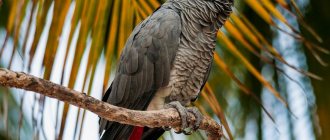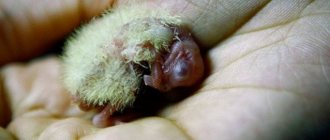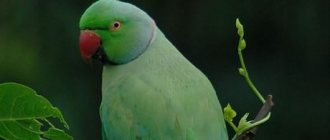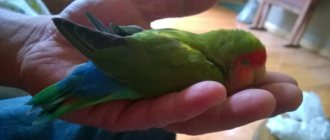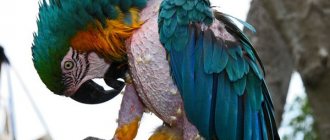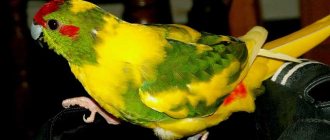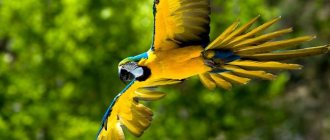Basic diet of budgerigars
Australia, a continent with a warm and even hot climate, is considered the birthplace of budgerigars. Here, about 40 species of plants are suitable for feeding birds, including leaves of trees and shrubs, as well as all the cereals growing there. Obviously, the best food for budgies should be as close as possible to the menu to which they are genetically adapted. The optimal solution in this case would be food that contains important grains for them: millet, oats, buckwheat, wheat, rice, crushed corn, sunflower seeds, as well as flax and various herbs. Many people try to prepare such mixtures on their own, but it is important to know that all components in this case must be mixed in strictly defined proportions using measuring spoons and glasses. In ready-made feeds, the necessary cereals are present in the required quantities.
Vegetables
Fresh vegetables are a source of vitamins and other nutrients. Before you give your feathered pet a slice of sweet carrots, you need to make sure that they are washed. It is advisable to feed your pets organic vegetables that were not fertilized with chemicals during the growth period. The diet for budgies at home should include the following types of vegetables:
- Carrots, turnips, and beets will definitely appeal to the feathered taste. Vegetables can be grated and mixed with boiled egg yolk. You can treat parrots with carrots in unlimited quantities.
- Zucchini, pumpkin and squash are sources of fiber. The seeds of these vegetables are especially valuable. If the grains are large, you should grind them before giving them to your pet, as the bird may choke.
- Tomatoes and cucumbers should also be served with seeds. It is unacceptable to feed parrots with unripe fruits, as they may contain toxic substances.
- Legumes in the form of beans, corn and green peas contain a large amount of useful substances. Their grains are very soft, so parrots can get carried away with such food. In this case, in order to prevent digestive upset, portions should be limited.
- White cabbage will provide the bird with important microelements. You can give your parrot both leaves and stalks. It is best to serve cabbage shredded.
- Bell peppers are a storehouse of vitamin C, which your feathered pet also needs.
Proper nutrition for a budgie is a balanced menu, which should contain the above-mentioned vegetables, but there are also plants that are strictly prohibited for the bird. We are talking about radishes, radishes, garlic, onions and eggplants.
How to diversify your budgie's menu
Grain food alone may not be enough for small feathered pets, and this is primarily due to the fact that they can quickly get bored with a monotonous diet, and this, in turn, leads to a decrease in appetite. It is also very important to provide the bird with a complete complex of vitamins and minerals, and this is only possible if the menu is sufficiently diverse. So, what else can you pamper your parrot with?
Sprouted feed
Sprouted seeds of buckwheat, oats and wheat contain fiber and vitamins that can provide the budgie with extremely important energy and protect against vitamin deficiency. The shelf life of such feeds in the refrigerator is only two days, so it is worth sprouting them in small portions and not giving the bird overcooked sprouts.
Fruits
Berries and fruits are the key type of succulent food that parrots need. However, not all fruits are suitable for them. On the list approved by veterinarians today:
- stone fruits (plums, apricots, peaches, cherries);
- melons (watermelons, melons);
- citrus;
- apples and pears;
- grape;
- kiwi;
- forest and garden berries.
It is necessary to give such treats to the bird in small portions and only in washed and peeled form. You can also include dried berries and fruits in your diet.
Vegetables
Vegetables are a real storehouse of minerals and vitamins, so adding them to the diet in small quantities will have a beneficial effect on the health of your parrot. The list of vegetables most preferred by birds includes:
- pumpkin (cucumbers, zucchini);
- legumes (beans, green peas);
- some nightshades (tomatoes, bell peppers);
- leaf salad;
- root vegetables (carrots, turnips, beets);
- corn.
Vegetables prepared for a parrot should be ripe, and corn should be of milky maturity. However, it is not necessary to clear them of seeds.
Grass and greenery
Including greenery and small twigs in the budgerigars’ menu is a must, as with their help they not only receive more nutrients, but can also quickly drain and clean their beak. As for branches, the birds can be offered resin-free and scalded shoots of birch, linden, maple, chestnut, ash, alder or beech, cut in ecologically clean areas. You can grow grass for your pet yourself from special mixtures. Only in this case can you be sure that it does not contain harmful components and parasites; moreover, such mixtures include the most beneficial plants for parrots, for example, Grass for your pets from AVZ.
Calcium in the diet
Parrots desperately need calcium. It strengthens the bones of the skeleton and the protective shell of eggs during oviposition. Feed chalk for parrots contains up to 40% calcium. In crushed form, this mineral fertilizer can be added to organic sand. Chalk in the form of a briquette can be fixed to the cage lattice.
It is important to buy chalk only for birds. Chalk for rodents contains salt, which poisons the body of parrots. During laying, you should also give calcium in powder form or add calcium gluconate ampoule to the water.
Eggshells are also an excellent source of calcium. It also contains magnesium, iron, phosphorus. Powdered shells are mixed with sand or given to parrots as a separate supplement.
What to feed your budgie besides dry food
Vegetables are simply necessary in the diet of budgies. It is better to tame them to vegetables from the very moment they leave the nest. It often happens that budgies do not recognize any food other than dry food. And it is impossible to explain to a parrot that food should be varied and balanced.
This often happens with parrots that are purchased at a pet store, where they often only give food from packages. Start with one fruit or vegetable, such as pumpkin or carrots. Grate it on the finest grater and place it in the feeder next to the main food. Perhaps the bird will not eat everything on the first day, but curiosity will prevail.
It is important for a parrot to rinse all vegetables well, and pour boiling water over those that cannot be peeled.
What vegetables and how to give them
- sweet bell pepper: a source of vitamins A, E, K, P, C, group B. It is better to cut the pepper into small slices, along with the seeds. You can also use hot pepper.
- raw carrots: rich in vitamin A. Can be finely chopped or grated. Mix with boiled eggs or vegetables.
- cabbage: grate a head of white cabbage or finely chop its leaves. Of Chinese cabbage, parrots can only eat the top part of the leaf. Treat all varieties of cabbage (white cabbage, Chinese cabbage, flowering cabbage, broccoli, kohlrabi) with boiling water to destroy harmful substances accumulated on the leaves. In addition, cabbage will be softer for parrots after blanching.
- tomatoes, cucumbers: parrots can only eat mature seasonal vegetables. Cucumbers are especially useful. Although they do not contain many vitamins, they are rich in iodine, which stimulates the appetite and improves digestion. Cucumbers and tomatoes can only be fresh.
- Beetroot: contains fiber, microelements and vitamins. It is better to grate it on a fine grater. Beets can only be given raw and in small quantities, as they have a laxative effect.
- pumpkin, turnips, squash, zucchini: rich in sugar and microelements. You can grate or cut into slices. Birds eat them well raw.
- legumes (green peas, beans, soybeans, lentils, chickpeas): choose only ripe or sprouted beans for your parrot. You can use them together with the pods.
- corn (small cobs): given to parrots fresh and when the grains are still young, soft and sweet. You don't have to peel the head of cabbage. Parrots are interested in separating grains on their own. Contains protein, starch, fiber and a lot of carbohydrates.
It is forbidden!!!
Eggplants (due to solanine), potatoes, garlic and onions are not allowed.
Fruits and berries
Vary your parrot's feeding with fruits. Peeled and processed fruits are placed in a separate feeder. What fruit to feed your budgie?
- Apples, pears. Peel and cut into pieces. Remove the seeds. They contain hydrocyanic acid, which can be dangerous for parrots. Pears are rich in fiber, and apples are rich in vitamin C and iron.
- Bananas, kiwi. Remove the peel before feeding. Banana contains potassium and starch.
- Pomegranate. Recommended in small quantities. And do not give if you have liver disease.
- Grape. Grapes are rich in antioxidants. Rinse well first.
- Sweet cherry, cherry, plum. Bones are not allowed. Plum is rich in potassium, magnesium, and phosphorus. Rinse well first.
- Watermelon. It is better for parrots not to overeat this berry, as it has a mild laxative effect. You can have both pulp and seeds. Give only in season, in small quantities.
- Rowan, blueberries, currants, cranberries, raspberries, lingonberries, strawberries, sea buckthorn. Berries can be harvested for the winter in the form of dried fruits. Their usefulness is not greatly diminished by this.
- Rose hip. Can be given fresh, steamed or dried.
It is forbidden!!!
You cannot feed your parrot persimmon, avocado, mango, or papaya. Their fruits contain many essential oils and tannins that are not perceived by the parrot's body!
Nuts are very fatty for budgies. You can't give them every day. This can cause obesity or indigestion. Give a small piece of walnut, hazelnut or cashew no more than 1-2 times a month as a treat.
What to feed your budgie (GREENS)
Fresh green food is an essential, complete vitamin component. Freshly picked greens should be included in your daily diet. Green plants can be collected not only in the garden (parsley, arugula, raspberry leaves, salads, grapevines), but also in fields and forests (plantain, dandelions, young tree branches with buds). Remember to rinse very well with water before feeding.
- Parsley. Contains vitamins C, P, folic acid, carotene, potassium salts, phosphorus, iron, magnesium, calcium. Give in limited quantities.
- Celery. Only green sprouts are allowed, roots are not allowed.
- Spinach. Can be given to parrots in very small quantities and in the absence of kidney disease.
- Young tree branches. Apple trees, rowan trees, chestnuts, plums, cherries, birches, currant and raspberry bushes are suitable. Parrots especially love young buds. Some owners of budgies give coniferous branches of pine and spruce. The peculiarity of pine needles is that it contains a large amount of vitamin C, essential oils, and fiber. But young branches of coniferous trees also contain resin, so it is advisable to bring them home only in winter.
- Green parts of vegetables: carrots, young radishes.
- Meadow herbs: dandelion, clover (both leaves and flowers), wheatgrass, plantain, fireweed, wood lice, nettle (be sure to pour boiling water over it), coltsfoot (both leaves and flowers), nasturtium, dandelions (and leaves , and flowers, and roots), tares, millet, timothy grass, etc.
It would seem that fresh green fertilizer can only be found in warm periods. And in winter? During the cold season, you can sow oats or millet for your budgie at home. You need to care for the plants in the same way as other indoor plants.
Attention! Plants!
By the way, about indoor plants. Many of them have caustic juice and this can be fatal to parrots. For example, alamanda, azalea, akalifa, amaryllis, begonia, hyacinth, hemanthus, dieffenbachia, crocus, clivia, primrose, nightshade, ivy, spathiphylium, all types of ficus, monstera, indoor fern, etc. are very dangerous!
Vitamin complexes and mineral mixtures for budgies
Due to anatomical features, such as the presence of a goiter, birds need gastroliths, i.e. sand and small pebbles. Also, the diet should contain certain minerals, such as sulfur, phosphorus, calcium, magnesium, iron. In pet stores you can buy special mineral stones, as well as chalk and sepia. It is not recommended to give vitamin complexes to children on purpose, since there is a very high risk of incorrectly calculating the dose. However, with the first renewal of plumage, it is necessary to maintain the balance of nutrients in the parrot’s body. To do this, you can give him vitamin solutions that will help shorten the molting period and quickly restore feather cover. There are also special preparations for normalizing metabolism and treating stress, and compositions to support the vital functions of birds during the period of bearing and raising chicks. You should not neglect them, because these are the drugs that help pets get through difficult periods without serious health consequences. For example, you can give your pet the combined multivitamin complex Radostin® Vitasil. It contains vitamin A, D3 and E. The components have a synergistic effect, which is expressed in increasing the body's resistance, normalizing metabolism, stimulating development, growth and productivity, especially during egg laying and feeding chicks. Attention! It is very important to strictly adhere to the dose and change the water with dissolved vitamins every day!
Basic diet
Dear readers who dream of a wavy friend, this information will be useful for you. The basis of a parrot's diet is dry food, it is designed specifically for the needs of the bird.
There is a great variety of food for parrots. Starting from the cheapest Russian ones like “VAKA” and ending with Italian branded ones. They are sold in packages from 500 grams to 2 kg. In addition, you can always buy food in large quantities - from 10 to 25 kg.
What do budgies love and look for among grains? In first place are fruits and vegetables. When purchasing food, pay attention to its composition. There must be the treats mentioned earlier. This is what ideal food for parrots looks like:
- yellow, red and white millet;
- canary seed;
- shelled oats;
- apple;
- pear;
- cookie.
The more fruit in the diet, the better for the bird.
Water for a budgie
Parrots need to drink regularly, since clean water helps to secrete gastric juice in the right quantities and promotes complete and healthy digestion. Lack of fluid can lead to poor absorption of nutrients from feed, insufficient saturation of organs and tissues with oxygen and, as a result, to serious diseases. That is why attention to the bird’s drinking bowl should be no less than to the contents of the feeder. Veterinarians recommend giving budgies bottled water intended for children - only in this case can you be sure of its safety, purity and sterility. Mineral and carbonated water, even from large, reputable manufacturers, is strictly contraindicated for birds, as it contains compounds hazardous to health. The water needs to be changed daily and the drinking bowl washed.
Mineral mixtures, vitamin supplements, fertilizers
Modern pet stores offer a wide range of mineral mixtures and stones. Budgerigars chew on this with joy. Thanks to this, they receive more comprehensive nutrition, rich in essential vitamins and minerals.
Sepia
For example, sepia is the shell of a cuttlefish, i.e. its inner part. It contains a huge amount of mineral salts of sodium, magnesium, phosphorus and calcium. Thanks to sepia, parrots “protect” their beak from deformation, curvature and grind off excess in time. Choose a white sepia color for your parrot, possibly with a yellowish tint. It may have a slightly fishy odor. Make sure there is no mold.
Mineral stones
Mineral stones contain calcium, magnesium, phosphorus, zinc, iron. This feeding is important for the bone structure of parrots. With a deficiency of phosphorus and calcium in parrots, parathyroid disease progresses, which entails fragility of the beak and bones, slower growth, and dystrophy.
Using a special device, attach the sepia or mineral stone directly to the cage bars so that the parrot always has free access to it. If your pets are afraid of a foreign object in the cage, place it near the cage for a few days so that they have time to get used to it.
Attention!
Pay attention to the sepia tone. Sometimes it can be very sharp and dangerous!
A separate feeder can contain a mineral mixture of organic sand, shell rock, clay, coral, sea shells, limestone, chalk and charcoal. All this can be purchased in finished form at pet stores.
Mineral organic sand (it is important not to confuse it with ordinary river sand) is crushed shell rock, corals, and sea shells. It helps grind food in the crop.
Sand and parrot.
A parrot that does not have digestive problems or other symptoms of illness will not eat organic sand constantly, so there is no need to remove it from the feeder. But the sand should be changed at least once a week. One budgerigar needs 2 teaspoons of the supplement.
Charcoal
Charcoal is made from birch wood. It is a storehouse of phosphorus, potassium, calcium, iron, and boron. Powdered charcoal is mixed with organic sand or eggshells. Coal is good at removing toxins, harmful gases and heavy metal salts from the body.
How to feed a sick budgie
Unfortunately, birds are not immune from diseases, and during the period of treatment and recovery, feathered pets require special care and, of course, special nutrition. As a rule, at this time the birds are too weak to peck at the usual grain food, so you need to take care of the menu for your pet separately. During illness, veterinarians most often suggest switching the parrot to liquid porridge, which you can prepare yourself in a blender. The finished mixture must be given to the bird from a syringe at least 3 times a day, and the portion should not be more than 1.5 ml. If the bird can eat on its own, it is better to offer it a mixture of millet, buckwheat and crushed wheat groats, boiled until half cooked. For diarrhea, rice porridge is recommended. A varied diet, only fresh foods and mineral supplements - all this will allow your parrot to remain cheerful and healthy throughout his life. It is also worth regularly consulting with a veterinarian about your pet’s diet in order to develop the most healthy and tasty menu for him.
How to cook porridge for a parrot
You can cook from one or a mixture of several grains at once. Here are two recipe options, based on different combined mixtures, with different compositions and different cooking methods. But both of these options are acceptable and loved by birds.
Recipe 1
To prepare you need to take:
- oats;
- fried buckwheat;
- green buckwheat (unfried);
- brown unpolished rice;
- water.
Prepare like this:
- Pour one teaspoon of cereal into a cooking container.
- Rinse everything in running water.
- Pour in a sufficient amount of filtered water.
- Place on the fire and bring to a boil over high heat.
- Cook over low heat for exactly 4 minutes.
- Remove from heat, cover with a lid and let steep for at least half an hour. You can leave it to steam overnight.
- Drain off excess water.
- All is ready.
Now you need to wait for it to cool down and you can give it to the parrots.
Important! The food should be lukewarm—barely above room temperature. It is prohibited to serve hot or cold porridge.
When serving, sprinkle with grated vegetables. The food is not very soft and boiled; the birds can just grab it with their beaks.
How to cook porridge for a parrot: video
Recipe 2
The following recipe is without cooking. For it you need to take:
- barley;
- buckwheat;
- yellow lentils;
- red lentils;
- mung bean;
- millet;
- rice;
- corn grits.
Find out if parrots can be given: eggs, cottage cheese, bread, grass, grapes, banana, orange, tangerine, cucumber.
Cooking:
- Place one teaspoon of each cereal in a thermos.
- Rinse.
- Pour hot water into the thermos.
- Leave to steam for 20 minutes.
- Strain the porridge from the thermos and rinse again using a strainer.
- Ready.
Ready-made food according to this recipe goes well with sprouted mung bean grains and medicinal herbs.
How to properly cook porridge for a parrot: video
Did you know? The normal body temperature of a parrot is 41
°C,
that’s why you can’t feed them cold food.
Treats for parrots
What do budgies like, besides their main food? Birds will not refuse treats. Sticks consisting of grains, vegetables, fruits and honey can be purchased at any pet store. When purchasing, study the composition, it varies. Birds are offered cereal sticks with honey, fruit sticks with cinnamon, and mineral sticks with vegetables.
There are crackers for parrots, dried fruits and berries, all of which are sold in pet stores.
Feed and grain mixtures
In pet stores you can find a lot of grain mixtures for budgies, often they include different varieties of millet, canary seed, and oats. Be sure to control the quality of the feed; it is better to purchase mixtures from trusted manufacturers in sealed packages, with detailed instructions.
You can also give your pets sesame seeds, meadow grass, flax, Abyssinian nougat, hemp seed, raw sunflower and pumpkin seeds. Nuts should not be given to the bird often - they are too fatty; once every two to three weeks you can give a piece of hazelnut, walnut or cashew.
Mineral components and vitamins
Eggshells contain calcium.
Mineral supplements are needed to provide the body with microelements that are necessary for the formation of skeletal bones.
The cage must contain sepia (part of the cuttlefish skeleton), which is an excellent source of calcium. Bird chalk or pre-boiled and dried eggshells also work well. For those who are just finding out what else a parrot eats at home, you should know about some more mineral supplements:
1. Bone meal. Together with egg shells, it is a source of phosphorus and calcium, which strengthens bones and feathers. Such additives are added to poultry sand or wet feed mixtures.
Flour is especially important during seasonal molting, because it nourishes the body of the wavy with salts, which are important in the formation of feathers. This simple and inexpensive feeding is sold in ordinary pet stores.
2. Small pebbles with sand. Under natural conditions, wild parrots eat such components along with other food. In the bird's stomach, they mechanically grind food and aid in digestion and enzymatic breakdown.
Sand for birds is sold everywhere in sealed packs. It is prohibited to use plain sand from beaches or construction sites, as there is a risk of parasite infection.
3. Charcoal. In nature, budgies get it from the bark of trees. It contains important microelements.
It is ground and sprinkled onto the birds along with egg shells and sand. It removes heavy compounds, poisons and gases from the organs of a feathered friend.
Is it possible to give food to people?
During lunch and dinner, people notice that the birds show interest in various unusual products, such as eggs, cottage cheese and even meat. It is allowed to include animal products in the diet, but rarely and in small quantities.
During molting or nesting, it is allowed to increase the amount of protein food, giving it every day.
Acceptable products from the common table include:
- low fat fermented milk cheese;
- boiled eggs;
- fish fat;
- skim cheese.
It is allowed to give a small amount of crackers, but fresh bread is prohibited. This is due to the presence of yeast, sugar, salt and milk. Rusks go well with a mixture of carrots and eggs. But it is advisable to give such components no more than twice a month.
Porridge
When studying what budgies eat, it is worth taking into account porridges from various cereal crops. They quickly saturate the body and also fill it with useful substances.
Porridges and various cereals have some important features:
- they contain important microelements that normalize impaired metabolism;
- In order to make porridge, you can use buckwheat, beans, rice and others. They can be used together or separately;
- Additionally, you can add legumes, finely chopped vegetables, fruits;
- It is recommended to boil porridge only in water without adding salt and sugar;
- You can store them in the refrigerator, but no more than two days.
We recommend reading: Budgerigar Lutino - a handsome yellow one

